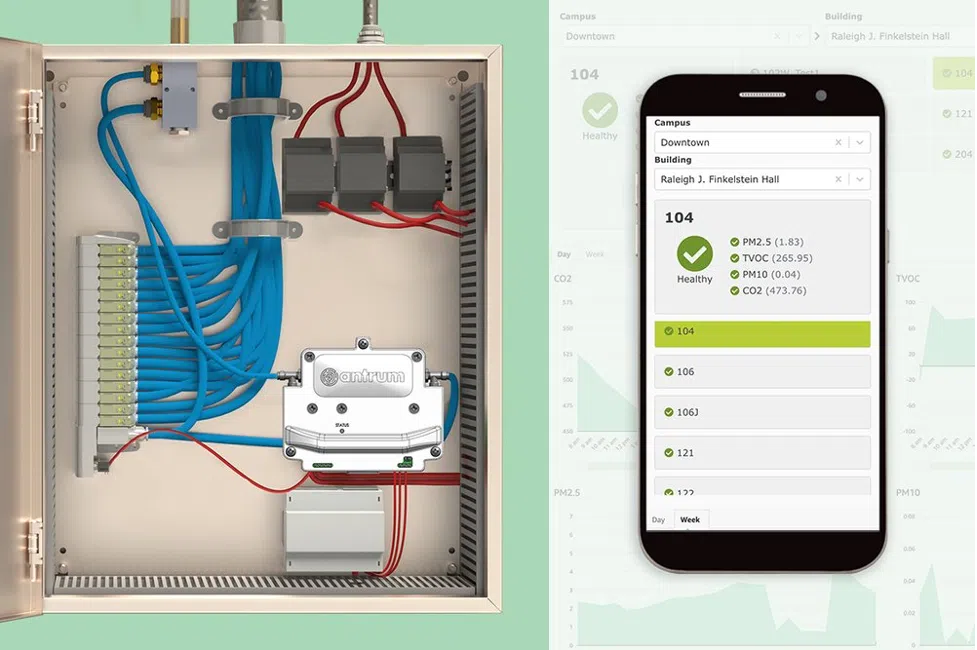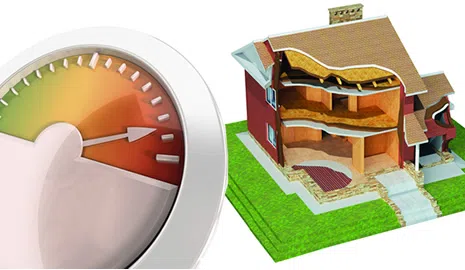Battery-less wireless automation brings benefits for both the hotel owner and the contractor.
Hotel owners are under great financial pressure when it comes to running their properties. Occupancy fluctuations, a highly competitive market and increasing energy costs are just some of the concerns facing the hospitality industry.
HVACR contractors can offer hotel owners significant energy savings at reduced risks and predictable costs through wireless energy management. The saving benefits are even higher when the modernized HVAC system is combined with an intelligent automation system.
Committed to Guest Comfort
For hotel owners and operators, however, fears of compromising guest comfort are often the greatest stumbling block when it comes to advancing energy management. The assumption that energy management solutions adversely impact guest comfort is largely unfounded.
From the contractor’s perspective, service calculations on a time and materials basis play a significant role. Before getting to work, the project site must first be evaluated, which includes a determination of how and where to pull wires for the sensors and switches.
Time for this activity, including drive-time, is not billable. Once the work on the project begins, other non-billable costs increase during jobs that span over multiple days. Each day requires setup, tear-down, clean-up and travel as well as an electrician’s time.
Burden of Batteries
Both constraints can be overcome by the use of wireless solutions. They can be flexibly placed and eliminate the need to install wiring and conduits. This significantly eases and reduces the planning and implementation effort. At the same time, these solutions can be installed in about the same amount of time a hotel room takes to clean.
There is the challenge of powering the devices. A larger system can comprise hundreds to thousands of these sensor devices all requiring power and communication capability. Battery-powered wireless devices can prove to be a drawback. Batteries last for only a limited time, depending upon the application, and must therefore be replaced regularly and disposed of properly. A large system installed in a comprising 10,000 wireless units, each powered by two batteries, could require the contractor to change approximately 30 batteries each day.
This increases the overall risk for the contractor and causes additional lifecycle costs over the contract period. Besides this, it could have a negative impact on the contractor’s reputation. Hotel owners probably won’t chose a partner who daily disturbs the guests with battery changes. In addition, batteries running out of power can lead to system down times. But downtimes are out of the question in the hotel contracting field where a service provider’s reliability is an essential competitive factor.
Self-powered Systems
Can the additional benefits of building automation and energy management only come at the cost of extensive renovation or high maintenance effort? How to solve the dilemma?
The answer is energy harvesting wireless technology. Today, self-powered wireless systems are found in all kinds of buildings in nearly all vertical markets. An energy harvesting wireless module gathers the power it needs to operate from the surrounding environment, including motion, light or changes in temperature. This allows control systems based on sensors and switches to operate independent of an external power supply such as wires or batteries. The ambient energy obtained in this way is sufficient to measure data and to send a wireless signal as a command and control message.
The messages sent by this wireless system are brief and repeated several times within a 40-millisecond time frame. By transmitting these data packets at random intervals, the devices ensure a very low probability of interference. As a result, there is no issue with operating a range of switches and sensors in close proximity to one another.
The range of battery-less wireless sensors is about 900 feet in open spaces and up to 90 feet inside buildings. Repeaters can be used to extend the signals. Energy harvesting wireless devices utilize the less crowded 902 MHz frequency band in North America. This offers a long range, robust and reliably performing ultra-low power radio communication while providing a safeguard against other wireless transmitters.

The Key to Energy Management
Based on battery-less wireless technology, an intelligent HVAC system can be realized by interconnecting automated thermostats, window contacts, key cards, humidity sensors, occupancy sensors and CO2 sensors. These are just a few examples of the self-powered products in place, to regulate climate control automatically. As battery-less devices use standardized communication and application profiles, contractors can flexibly combine solutions from different vendors.
At the heart of such a battery-less wireless in-room energy management solution could be the wireless keycard. Upon entering the room, the guest initiates control of the lighting, HVAC system, and television by simply inserting the keycard into the wall mounted keycard reader. The wireless signal is just powered by the movement of sticking the card into the reader.
Guests use the same key that they are given upon check-in. Lighting, TV and temperature control are operated normally while the room is occupied. When guests leave and remove the keycard, all room lighting is turned off, the television is powered down and the HVAC system is set back into “eco saving” mode.
As a substitute, or in addition to the keycard system, a wireless motion sensor can be utilized which provides presence data for an automated control of all electricity consumers in the room. Incorporating a window/balcony door sensor in properties where windows or patio doors can be opened allows the system the ability to detect open windows or balcony doors and can thereby cycle off the heating or cooling unit.
The wireless sensors and switches inside the guest room can be implemented as a stand-alone system, or can communicate to an access point located in the hallways scattered throughout the hotel. The data collected by the access points is directed to a server via TCP/IP. If needed, this system can be tied into an existing BAS or to a property management system.
Savings as a Service
The inclusion of a software-based platform ties the entire system architecture together by integrating data from multiple access points into a centralized aggregate for the management and control of lighting, heating, cooling and security systems. Such a system features the ability to monitor actual power, water and gas consumption, includes pricing information and has the ability to attach functions, macros and conditions to actual consumption, meter reading and pricing data.
Contractors can offer such an integrated energy solution as management-as-a-service and monitor important inventory, equipment, assets and energy-related information remotely.
One of the major advantages of a cloud-based solution is that the contractor can provide the energy management system to the hotel completely pre-commissioned from the manufacturer. Ongoing commissioning is done as a service via the cloud, too. The system of battery-less wireless sensors and switches can be flexibly installed without pulling wires.
Once commissioned, it doesn’t need any maintenance over the devices’ complete lifecycle keeping lifecycle costs low and predictable. In addition, the system can be extended at any time – a valuable extra service that contractors can provide their customers.
Aloha Surf Hotel Rides Energy Efficiency Wave
 The Aloha Surf Hotel in Waikiki, part of Hawaii’s first boutique hotel chain, Aqua Hotels & Resorts, uses a battery-less wireless automation system to significantly reduce its energy consumption. As part of their green initiative, the hotel installed self-powered key card switches in all 204 guestrooms. The team was able to complete about 15 rooms per day, which meant little to no disruption to daily hotel operations.
The Aloha Surf Hotel in Waikiki, part of Hawaii’s first boutique hotel chain, Aqua Hotels & Resorts, uses a battery-less wireless automation system to significantly reduce its energy consumption. As part of their green initiative, the hotel installed self-powered key card switches in all 204 guestrooms. The team was able to complete about 15 rooms per day, which meant little to no disruption to daily hotel operations.
The installed energy management solution utilizes a key card switch to automatically control both the HVAC and the lighting in the guest’s room. When guests enter their rooms, they place their key card into the key card switch located inside the entry way, thereby activating the thermostat control unit, bringing it into “occupied” mode.
When the guest leaves the room, he removes the key card from the key card switch and both the thermostat and the lights return to energy saving mode. Most rooms also have a battery-less, wireless balcony door sensor. When the balcony door is opened, a signal is sent to the in-room HVAC unit, which switches off, until the balcony door is closed.
The key card-based energy management system has been in place since January 2012 and the savings are significant. With respect to lighting, the system has resulted in an average of 45 percent energy savings. The energy savings for the HVAC system, which is where the larger load exists, is about 50 percent.
The estimated modeling criteria allocated approximately 70 percent of the consumption to the guest rooms and 30 percent to the common areas. The combined KWh savings conservatively amount to an estimated $44,043 annually. These results show an ROI without rebate incentives of 15.2 months. When factored in an additional rebate of $125 per room, for a total of $25,500, from Hawaii Energy, the recalculated ROI is 8 months.
Benefits for Both
Incorporating battery-less wireless energy management solutions into hotels can be accomplished without the costs and burden of expensive, disruptive installations. Wireless systems can be deployed in hotel rooms without needing to take rooms out of commission during installation. All rooms can be pre-configured and fully programmed so that they are ready for easy installation.
The main driver for the implementation of such an energy management solution is economic. Hotels that incorporate HVAC control can expect energy savings of between 20 and 40 percent, which typically represents simple paybacks of less than 3 years. This represents a strong and sustainable business model for contractors as well as for hotel owners resulting in a real win-win partnership.
 Graham Martin is chairman of the EnOcean Alliance and has 25 years experience in analogue and RF solutions at various Engineering, Sales and Marketing positions in USA, GB, Germany, Austria and Norway. Before joining EnOcean he was a worldwide pioneer in low power wireless sensor networks at leading start-up Chipcon (purchased 2006 by Texas Instruments) where he conducted the worldwide business development activities, served as President of Figure8Wireless and was Vice President of the ZigBee Alliance. For additional information, visit www.enocean-alliance.org.
Graham Martin is chairman of the EnOcean Alliance and has 25 years experience in analogue and RF solutions at various Engineering, Sales and Marketing positions in USA, GB, Germany, Austria and Norway. Before joining EnOcean he was a worldwide pioneer in low power wireless sensor networks at leading start-up Chipcon (purchased 2006 by Texas Instruments) where he conducted the worldwide business development activities, served as President of Figure8Wireless and was Vice President of the ZigBee Alliance. For additional information, visit www.enocean-alliance.org.



 The Aloha Surf Hotel in Waikiki, part of Hawaii’s first boutique hotel chain, Aqua Hotels & Resorts, uses a battery-less wireless automation system to significantly reduce its energy consumption. As part of their green initiative, the hotel installed self-powered key card switches in all 204 guestrooms. The team was able to complete about 15 rooms per day, which meant little to no disruption to daily hotel operations.
The Aloha Surf Hotel in Waikiki, part of Hawaii’s first boutique hotel chain, Aqua Hotels & Resorts, uses a battery-less wireless automation system to significantly reduce its energy consumption. As part of their green initiative, the hotel installed self-powered key card switches in all 204 guestrooms. The team was able to complete about 15 rooms per day, which meant little to no disruption to daily hotel operations. Graham Martin is chairman of the EnOcean Alliance and has 25 years experience in analogue and RF solutions at various Engineering, Sales and Marketing positions in USA, GB, Germany, Austria and Norway. Before joining EnOcean he was a worldwide pioneer in low power wireless sensor networks at leading start-up Chipcon (purchased 2006 by Texas Instruments) where he conducted the worldwide business development activities, served as President of Figure8Wireless and was Vice President of the ZigBee Alliance. For additional information, visit
Graham Martin is chairman of the EnOcean Alliance and has 25 years experience in analogue and RF solutions at various Engineering, Sales and Marketing positions in USA, GB, Germany, Austria and Norway. Before joining EnOcean he was a worldwide pioneer in low power wireless sensor networks at leading start-up Chipcon (purchased 2006 by Texas Instruments) where he conducted the worldwide business development activities, served as President of Figure8Wireless and was Vice President of the ZigBee Alliance. For additional information, visit 

